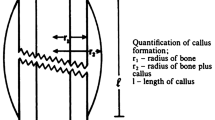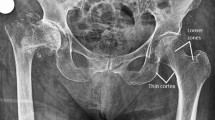Abstract
Patients suffering from severe head injury and fractures of long bones or large joints often show enhanced osteogenesis, with hypertrophic callus formation and/or heterotopic ossifications. The advantage of this phenomenon is early consolidation of the fractures. An extreme disadvantage is extensive periarticular calcification, resulting in complete ankylosis of the affected joint. In spite of numerous efforts aimed at clarifying the way in which severe head injury can influence osteogenesis at a distant site, this phenmenon is still not understood. The process, once started seems irreversible, but if diagnosed in time, could be prevented with non-steroid anti-inflammatory drugs that inhibit development of heterotopic ossifications. The major prerequisite for testing this possibility is to define parameters of an early diagnosis of enhanced osteogenesis. Thus, the aim of this study was to test whether serum values of some parameters related to bone regeneration could allow an early prediction of enhanced ossification following bone fracture in patients with severe head injury. Samples of sera were obtained from three groups of injured patients: fractures of long bones or large joints only (n=6), severe head injury only (n=8), severe head injury and fractures of long bones and large joints (n=7) and from a group of apparently healthy volunteers (n=10). The values for alkaline phosphatase (ALP), the bone isoenzyme, and the carboxy terminal propeptide of type I procollagen (PICP) were significantly higher (5–20 times as high) in patients with severe head injury and bone or joint fractures than in any other group. Significantly increased concentrations of PICP were already found in the 1st week after injury, and those of ALP and of the bone isoenzyme increased during the 2nd week after injury. Results show that these parameters are helpful for an early diagnosis of enhanced osteogenesis and heterotopic ossifications in patients with severe head injury and bone fractures. Further studies are necessary to verify these findings, while analysis of reasons for the specific patterns of dynamic change of these parameters could lead to better understanding of the mechanisms underlying the uncontrolled bone formation.
Similar content being viewed by others
References
Bidner SM (1990) Evidence for a humoral mechanism for enhanced osteogenesis after head injury. J Bone Joint Surg [Am] 72:1144–1149
Bucher NLR (1963) Regeneration of mammalian liver. Int Rev Cytol 15:245–300
Burgeson RE (1988) New collagens, new concepts (review). Annu Rev Cell Biol 4:551–577
Canalis E (1985) Effect of growth factors on bone cell replication and differentiation. Clin Orthop 193:246–263
Carey DE, Goldberg B, Ratzan SK, Rubin KR, Rowe DW (1985) Radioimmunassay for type I procollagen in growth hormone deficient children before and during treatment with growth hormone. Pediatr Res 19:8–11
Diduch DR, Coe MR, Joyner C, Owen ME, Balian G (1993) Two cell lines from bone marrow that differ in terms of collagen synthesis, osteogenic characteristics, and matrix mineralization. J Bone Joint Surg [Am] 75:92–105
Einhorn TA (1992) Bone remodelling in fracture repair. Triangle 31:89–98
Einhorn TA, Simon G, Devlin VJ, Warman J, Sidhu SPS, Vigorita VJ (1990) The osteogenic response to distant skeletal injury. J Bone Joint Surg [Am] 72:1374–1378
Elmstedt E, Lindholm TS, Nilsson OS, Törnkvist H (1985) Effect of ibuprofen on heterotopic ossification after hip replacement. Acta Orthop Scand 56:25–27
Gowen M (1992) Cytokines and bone metabolism. CRC Press, Boca Raton, Fla
Groswasser Z, Reider-Groswasser I (1986) Heterotopic new bone formation in the cervical spine following head injury, J Neurosurg 64:513–515
Jingushi S, Joyce ME, Bolander ME (1992) Genetic expression of extracellular matrix proteins correlates with histologic changes during fracture repair. J Bone Miner Res 7:1045–1055
Joerring S, Jensen LT, Andersen GR, Johansen JS (1992) Types I and III procollagen extension peptides in serum respond to fracture in humans. Arch Orthop Trauma Surg 111:265–267
McKibbin B (1978) The biology of fracture healing in long bones. J Bone Joint Surg [Br] 60:150–162
McLaren AC (1990) Prophylaxis with indomethacin for heterotopic bone. J Bone Joint Surg [Am] 72:245–247
Mohan S, Baylink DJ (1991) Bone growth factors. Clin Orthop Rel Res 263:30–48
Nast-Kolb D, Jochum M, Waydhas C, Schweiberer L (1991) Die klinische Wertigkeit biochemischer Faktoren beim Polytrauma. Hefte zur Unfallheilkunde. Springer, Berlin Heidelberg New York
Parfitt AM, Simon LS, Villanueva AR, Krane SM (1987) Procollagen type I carboxy-terminal extension peptide in serum as a marker of collagen biosynthesis in bone. Correlation with iliac bone formation rates and comparison with total alkaline phosphatase. J Bone Miner Res 2:427–436
Perkins R (1987) Callus formation and the rate of healing of femoral fractures in patients with severe head injuries. J Bone Joint Surg [Br] 69:521–524
Prockop DJ, Kivirikko KI, Tuderman L, Guzman NA (1979) The biosynthesis of collagen and its disorders (review). N Engl J Med 301:13–23; 77–85
Randall JC, Morris DC, Tomita T, Anderson HC (1989) Heterotopic ossification: a case report and immunohistochemical observations. Hum Pathol 20:86–88
Ritter M (1987) Indomethacin: an adjunct to surgical excision of immature heterotopic bone formation in a patient with a severe head injury. Orthopedics 10:1379
Sandberg M, Aro H, Multimaki P, Aho H, Vuorio E (1989) In situ localization of collagen production by chondrocytes and osteoblasts in fracture callus. J Bone Joint Surg [Am] 71: 69–77
Smith R (1987) Head injury, fracture healing and callus. J Bone Joint Surg [Br] 69: 518–520
Sodemann B, Persson PE, Nilsson OS (1988) Prevention of heterotopic ossification by nonsteroid antiinflammatory drugs after total hip arthroplasty. Clin Orthop Rel Res 237: 158–163
Solheim E, Pinholt EM, Bang G, Sudman E (1992) Inhibition of heterotopic osteogenesis in rats by a new bioeridible system for local delivery of indomethacin. J Bone Joint Surg [Am] 74:705–712
Spencer RF (1987) The effect of head injury on fracture healing. J Bone Joint Surg [Br] 69:525–528
Urist MR, DeLange RJ, Fnerman GAM (1983) Bone cell differentiation and growth factors. Science 220:680–686
Wildburger R, Schweighofer F, Passler JM, Hofer HP (1992) Heterotope Ossifikationen bei einem Patienten mit schwerem Schädel-Hirn-Trauma. Zentralbl Chir 117:515–519
Wozney JM, Rosen V, Celeste AJ, Mitsock LM, Whitters MJ, Kriz RW, Hewick RM, Wang EA (1988) Novel regulators of bone formation: molecular clones and activities. Science 242:1528–1534
Zarkovic N, Stipancic I, Hrzenjak M, Ilic Z, Kis S, Vuckovic I, Jurin M (1993) The influence of liver regeneration on skin wound healing and lymphocyte growth features. In Faist E, Meakins J, Schildberg FW (eds) Host defense dysfunction in trauma, shock and sepsis. Springer, Berlin Heidelberg New York:1085–1093
Zernik J, Twarog K, Upholt WB (1990) Regulation of alkaline phosphatase and alpha 2 (I) procollagen synthesis during early intramembranous bone formation in the rat mandible. Differentiation 44:207–215
Author information
Authors and Affiliations
Rights and permissions
About this article
Cite this article
Wildburger, R., Zarkovic, N., Dobnig, H. et al. Post-traumatic dynamic change of carboxyterminal propeptide of type I procollagen, alkaline phosphatase and its isoenzymes as predictors for enhanced osteogenesis in patients with severe head injury. Res. Exp. Med. 194, 247–259 (1994). https://doi.org/10.1007/BF02576386
Received:
Accepted:
Issue Date:
DOI: https://doi.org/10.1007/BF02576386




